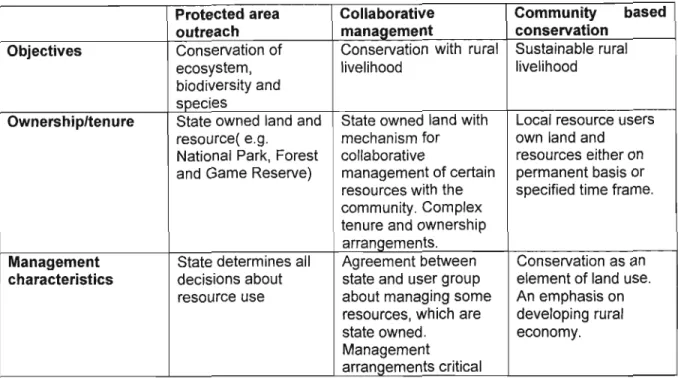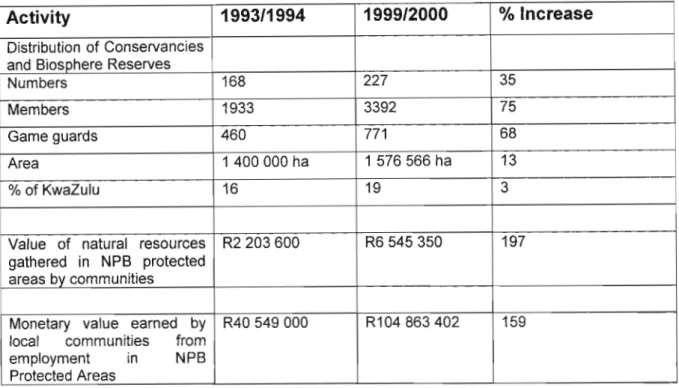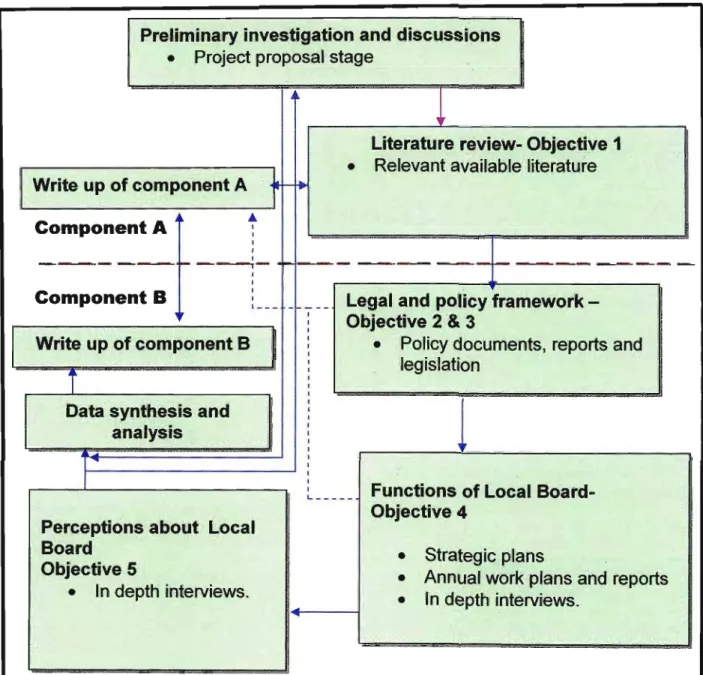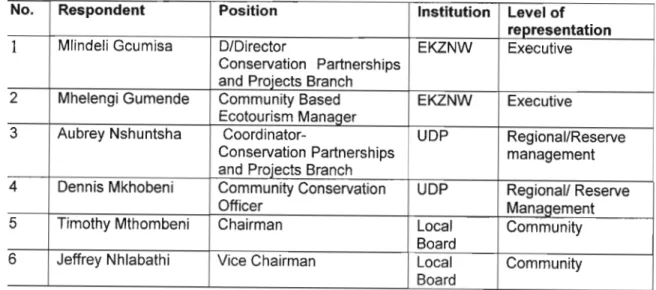This mini-dissertation represents the author's original work and has not been otherwise submitted in any form for any degree or degree at any university. Where the work of others has been used, this is duly acknowledged in the text.
OVERVIEW
- Introduction
- Structure of the dissertation
- Structure of component A
- Concepts and definitions
- Protected area
- Community conservation
- Community
- Local participation
- Stakeholder
- Policy
- Institution
- Rationale behind the study
- The research questions
- Aims and objectives
- Limitations and outcome of the study
Prominence of the concept of local participation in the field of conservation led to the development of the philosophy of community conservation (Barrow & Hulme 2001). This study aims to analyze the legal mandate, policy framework and implementation of the Local Council in the Ukhahlamba-Drakensberg Park.
CONCEPTUAL FRAMEWORK
Conceptual context
Within the province's prerogative, the KwaZulu-Natal Provincial Government enacted the KwaZulu-Natal Nature Conservation Management Act. Under this Act, the establishment of the KwaZulu-Natal Nature Conservation Board and the Nature Conservation Service is mandated.
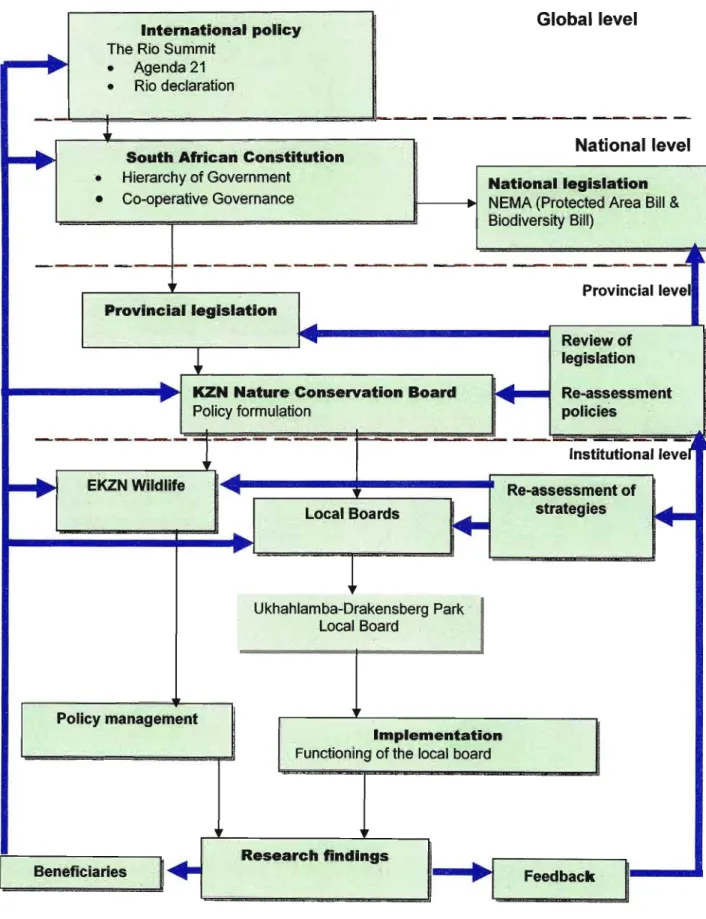
LITERATURE REVIEW
Historical context of conservation in South Africa
In the Transvaal, this was the decade in which Paul Kruger became president, and the establishment of the early game reserves was closely linked to his drive. There were thus two manifestations of a wildlife protectionist policy visible in the Transvaal; the restrictions on hunting and the establishment of game reserves.
Community conservation
Conservation during the era that followed featured the establishment of protected areas such as the National Park as a prominent conservation measure. Protected areas such as national parks and game reserves, in addition to being national assets, have not directly benefited local livelihoods but have been solely state property and responsibility.
Approaches to community conservation
- Protected area outreach
- Collaborative management
- Community based conservation
Community Based Management Strategy where a 'community' ownership or conservation appropriate approval is granted for the management of natural resources that have a local value. Collaborative management Management strategy where community and a conservation authority work together to manage a resource(s) or area of regional, national or international value. The management of the resource is governed by a negotiated framework, which defines the roles and responsibilities of the cooperation partners.
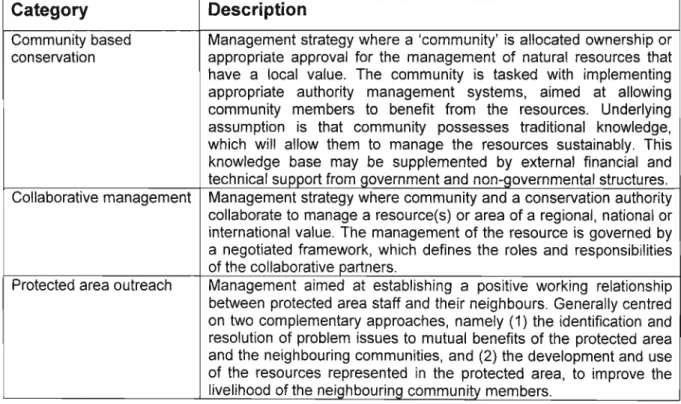
Participation and community conservation
- Passive participation
- Active participation
Passive participation People participate by hearing what is going to happen or has already happened. In contrast, the functional, interactive and self-mobilizing typology of participation (Table 3.3) includes local involvement in activities, participation in decision-making and empowerment.
Local participation; a case for South Africa
In 2001, the Department of Environmental Affairs and Tourism (DEAT) initiated and adopted a bioregional approach to South Africa's protected areas. Within the same vision, DEAT agrees with the Kumleben report, which recommends the involvement of local communities in the future management of protected areas.
Local Participation; a case for KwaZulu-Natal
As part of the sharing policy, the DNC introduced the idea of sharing revenues from protected areas with the traditional authorities neighboring the protected areas who received 25. The institution also allowed the collection of a wide range of natural materials by local people from the protected areas under its jurisdiction (Table 3.6).
The Local Boards in KwaZulu-Natal
The Act also empowers the KZN Provincial Minister of Agriculture and Environmental Affairs to establish Local Boards for protected areas. Local Boards consist of sectoral representation from traditional authorities, business sectors, formal agriculture, regional tourism, regional councils and other interest groups.
Conclusion
They also differ in their mandate and responsibility, in the resources they address, in the organizational characteristics they exhibit and the manner of implementation. At the provincial level, the entrenchment of community structure in the legal framework in KwaZulu-Natal is one such effort in the ongoing review of the legislation, while the establishment of the Local Councils forms part of pilot implementation practices of community preservation from which lessons must still be learned.
Introduction
Methodology process
Sampling technique
Study procedure
Methods of data collection
Methods of data analysis
Assumptions and anticipated problems Assumptions
Some local board members may not be readily available due to traditional protocol or other commitments, and this may result in delays in planned data collection. Some local board members may not be fluent in English and this may create a language barrier between the interviewee and the interviewer.
Involving local people in protected area management: the experience of local governments in KwaZulu-Natal, South Africa. A decade of biodiversity conservation and use in South Africa: tracking progress from the Rio Earth Summit to the World Summit on Sustainable Development in Johannesburg.
APPENDIX A: INTERVIEW INSTRUMENT
- Board formation and composition
- Functioning of the Local Board
- Community levy and other benefits
- Integration of the activities of Protected Areas with those of the surrounding areas
- General comments, opinion and observations
The third part of this interview deals with the management plans and the role of the LB. 11. How does the LB participate in the compilation and monitoring of the management plans for the park. 12. What is the role of the LB in the implementation and delivery of community levy.
Integration of the activities in protected areas with the activities in the surrounding areas, the surrounding areas. The fifth part of this interview is about the aspect of integrating the activities in protected areas with the activities in the surrounding areas. One of the objectives of the establishment of the local board as outlined in the KwaZulu-Natal Nature Conservation Management Act.
What is the role of the LB in the cross-border arrangement of Maluti Ukhahlamba-Drakensberg Park.
COMPONENTB
ABSTRACT
INTRODUCTION
Conservation authorities in Africa are faced with the challenges and obligations of involving local people in the management of protected areas. Protected areas in Africa have led to forced removal of local populations and loss of access to biological resources on which their livelihoods depend. Recently, the argument has been that conservation should involve local communities rather than being purely a state responsibility, and that rural communities in Africa should no longer be seen as barriers, but as active partners and beneficiaries of conservation (Anderson & Grove 19987; Hulme & Murphree 2001).
As a provincial nature conservation service founded on the merger of two conservation agencies, it faces the challenges of the changed legislation from pre-1994 to post-1994 and the imperatives of involving local people in nature conservation in KwaZulu-Natal (KZN) province. This study focused on the implementation of the local board's approach to community involvement, with Ukhahlamba-Drakensberg Park as a case study. The research was based on two key questions; how has EKZNW adapted to changed legislation and society's perspective in nature conservation.
What perceptions and understandings guided the level of local committee implementation in the Ukhahlamba-Drakensberg Park.
METHOD
RESULTS
- Introduction
- Legislation
- Policy framework
- Perceptions about the Local Board
The local board is an independent statutory legal entity but operates within the policy framework of the KZN Nature Conservation Board. Therefore, implementation by the local board depends on the policy of the KwaZulu-Natal Nature Conservation Board. The KwaZulu-Natal Nature Conservation Management Act outlines the purpose of the establishment of the local boards.
The key objective of establishing a local committee is to promote and facilitate local decision-making in the management of nature conservation and heritage resources. The responses to inquiries in this regard indicate an appreciation of the criteria and procedure for establishing a local committee. Answers to questions about the functions of the local board reveal agreement in some areas and differences in others.
Inquiries about this reveal that the local council is part of the process, but not necessarily the final authority.
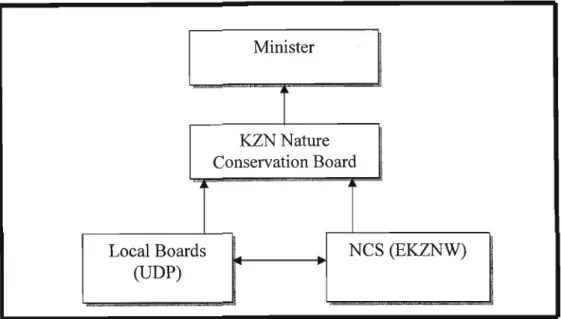
DISCUSSION
- Establishment process and functions of the Local Board
- Perceptions of role players about the Local Board
The local board also drives the process for establishing a local board and the local board's mandate. The findings in this thesis reveal that the local board is established on the basis of the legal obligation. This reinforces the view that the success of the local government concept is initially manifested in the legally constituted social structures.
This suggests that the roles of the Local Council and that of the Municipalities should be carefully reviewed. The reserve management level recognizes the limited capacities in the Local Board members which suggests that further guidance on the criteria is required. The reserve management level observed operational complexities in the role of the Local Council and that of municipalities.
The establishment of the Local Council is appreciated in the context of legally constituted community structures.
CONCLUSION AND RECOMMENDATIONS
- Recommendations
The implementation of the local committee encountered difficulties due to a lack of understanding by members of their role and the capacity of EKZNW staff. However, both local committee members and EKZNW staff are working to resolve these issues. The local committee is established in such a way that it operates on the basis of supplementary funding and does not have a financial basis, which affects its effectiveness.
In this regard, the need for an operational budget for the Local Board becomes imperative. The role of the Local Board and that of the Municipality should be clarified by the competent authority. The mechanism for creating reliable sources of financial base for the Local Board should be explored.
More research should be encouraged as part of the monitoring system for the implementation of Local Government and the changing perceptions about it.
ACKNOWLEDGEMENTS
APPENDIX B: INTERVIEW DETAILS
With reference to the functions of the local board, what is the role of the local board. With regard to the provision of community tax and other community benefits, what is the role of the Local Board. What constitutes community in the local board's mandate, and how are the recipients of community tax determined.
With reference to the role of the local council; what is the function of the local council. How does the local council participate in the compilation and monitoring of the plans for the park. What are your observations and views on that arrangement for the appointment of the Local Board.
According to the tasks of the local board; what is the role of the Local Committee. Who outlines or should outline the guidelines for the operation of the Local Committee. In relation to community levy and other community benefits; what is the role of the Local Committee.
